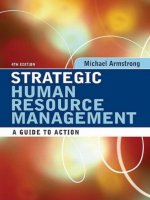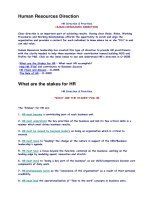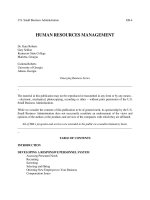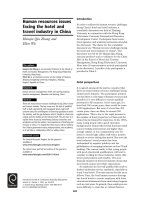Human Resources Direction
Bạn đang xem bản rút gọn của tài liệu. Xem và tải ngay bản đầy đủ của tài liệu tại đây (134.44 KB, 6 trang )
Human Resources Direction
HR Direction & Priorities
HUMAN RESOURCES DIRECTION
Clear direction is an important part of achieving results. Having clear Goals, Roles, Working
Procedures and Working Relationships affords the opportunity to enroll and align the
organization and provides a context for each individual to know where he or she "fits" in and
can add value.
Human Resources leadership has created this type of direction to provide HR practitioners
with the clarity needed to help them maximize their contribution toward building NOS and
Profits for P&G. Click on the items below to see and understand HR's direction in O-2005.
· What are the Stakes for HR - What must HR accomplish?
· How HR "Fits" and contributes to Business Success
· HR Vision and Mission - O-2005
· The Role of HR - O-2005
What are the stakes for HR
HR Direction & Priorities
"WHAT ARE THE STAKES" FOR HR
The "Stakes" for HR are:
1. HR must become a contributing part of each business unit.
2. HR must understand the key priorities of the business and link its few critical skills in a
manner which most drives business results.
3. HR must be viewed by business leaders as being an organization which is critical to
success.
4. HR must move to "leading" the change of the culture in support of the CEO/Business
leadership's agenda.
5. HR must have a focus beyond the function; centered on the business; working on the
leading edge by modeling speed, innovation and stretch.
6. HR must move to "being a key part of the business" as our skills/competencies become core
components of daily work.
7. HR professionals serve as the "conscience of the organization" as a result of their personal
credibility.
8. HR must lead the operationalization of "flow to the work" concepts in business units.
How HR "Fits" and contributes to Business Success
HR Direction & Priorities
Human Resources 0-2005
How HR "Fits" and Contributes to Business Success
Introduction
The term "Fit" is often used by organizational experts to describe how an organization or an
individual makes a contribution in the overall scheme of things . . . how all those contributions
"fit" together. The idea is that if done properly, people and organizations come together with
the skills and clarity needed to be able to make their "value added" contribution to the
strategies of the enterprise. Said another way, if I have the skills, if I'm in the right place,
and if I'm clear on what we're trying to do . . . I can understand how to contribute and
make a difference in outcomes.
For Human Resources, our ability to contribute flows from knowing what P&G is trying to
accomplish; what our function's unique contribution is; what our role in the organization is;
what skills or competency areas are important for making the needed contributions and where
in the different parts of the organization they can be made.
When we think about how to explain our contribution and how we "fit" in a clear manner,
putting it in the context of the business, using a "Thought Model" is helpful, as we can see it
all together on one page.
The Thought Model – HR's Contribution in Context
The Thought Model attached has five elements or "frames", which for our example will read
from the top left to top right, and then top right to bottom. It can also be read from
bottom to top left once HR is understood in context as the flow designated by arrow
connecting the frames indicates.. In the first frame we see what P&G must become to be
successful in the new world; think of this as a successful outcome of the O-2005 change
effort. We must become a virtual organization, linked electronically to our customers and our
consumers. This means an organization vertically integrated at some point in the future with
the world's top 20 customers to form an entity which links us quickly, clearly and effectively
to global consumers. Some consumers will come to us via e-Commerce directly; others via our
"straight line" link to them with our customer/partners who are able to innovate, respond and
cycle quickly on a real-time/virtual basis.
The second frame, to the left of frame one, defines "what HR is here for"; i.e., the unique
contribution that Human Resources makes toward P&G's achievement of the outcome described
in frame one. Think of this as the "Mission" of HR. It defines our contribution as experts in
creating and continually improving the culture needed to deliver the strategies of the
Company. The creation of this "alloy" of strategy and culture is the key to P&G's competitive
success, as organization/culture has become in most minds the only competitive weapon left.
"Traditional forms of competitiveness, such as cost, technology, distribution, manufacturing
and product features can all be copied," says management consultant and HR's leading edge
thinker, David Ulrich. "They have become table stakes, you must have to be a player; but
they do not guarantee you'll be a winner. In the new world winning will spring from
organizational capabilities such a speed, responsiveness, learning capability and employee
competencies." Hence, the way we design, deploy and develop the organization is the key to
P&G's competitive success, and the "linchpin" of HR's contribution.
Moving down the page, the third frame defines the "roles" HR plays in ensuring this
competitiveness. HR makes its contributions in the business as a Business Partner, a Change
Agent, an Employee Champion, and as an Administrative Expert in the delivery of services.
Frame four identifies the "core" skill bundles that outline what Human Resource professionals
"need to know" and be able to contribute with excellence to ensure the company (individuals
and organizations) is able to achieve its strategies. There are Five Critical/Core Skills or
Areas of Competency: Understanding of the Business; The Ability to Manage Change and
"Make It Happen"; The Ability to Create and Manage Culture; The Management of HR
Practices/Deliver HR; and Having Personal Credibility With Leaders. Note that each speaks to
adding value in daily operations through the development of leaders, teams and employees,
and ensuring that the fundamental systems and processes of HR are in place for no
disruptions or distraction of operations.
Frame five depicts how Human Resources organizes or structures itself to provide support to
the business. Note there are four areas where services are delivered: the MDOs focused on
enabling us to "go to market" as a company, and where HR helps develop high performing
teams and provides support for delivery of local HR systems: the GBUs where we partner with
line leaders and their teams to operationalize the linkages between strategies and culture; the
GBS where we focus on the effective and efficient "delivery of HR's basic processes" and the
ability to impact results through holding the line on costs; and the small core HR Function
which provides "deep" support and expert resourcing to HR practitioners in line operations and
in the other functions.
HR Vision
HR Direction & Priorities
Vision – P&G Human Resources in the Year 2005
Procter & Gamble's Human Resource Function (HR) has become the world-class standard by
which other Human Resources organizations are measured. These HR professionals are highly
competent and knowledgeable, and because of their functional expertise, complemented by an
external focus, they are considered to be both valued business partners and employee
champions. In partnership with the CEO and line management, HR is the catalyst for
'unleashing the power' of the strategic human capital of the corporation, and is the primary
driver for linking the Company's strategic business direction with organization and individual
capability. The function accomplishes this through high leverage leadership and functional
mastery in the management of:
1) Partnerships with Business Leaders;
2) By Driving Change and Managing Transformation;
3) Through The Ability to Create and Manage Culture;
4) By the Management of HR Practices/Delivery of HR Systems with Excellence;
5) Through Personal Credibility and Influence of individuals and groups.
The pride, passion, technical mastery and excellence which HR professionals continually
demonstrate have caused line business leaders internally, and outside companies, to seek us
out for support and for our learnings.
Mission Statement
· Develop individual and organizational capability.
· Provide employee services.
· Assure the value-based culture which will drive the change needed to achieve business
results.
HR Mission - Capability
HR Direction & Priorities
Capability
· Diversity
· Change Management
· Organization Design
· ER/LR
· Organization Development
· Acquisitions
· Training
· Organization Assessments
· Communication
· Leadership
· Staffing
HR Mission - Employee Service
HR Direction & Priorities
Employee Services
· Compensation
· Benefits
· Recruiting
· Employee Data
· Policy
· Relocation
· Medical
· Security
The Role of HR
HR Direction & Priorities
HUMAN RESOURCES - O-2005
THE ROLE OF HUMAN RESOURCES
Introduction
The world of O-2005 and beyond has caused HR, like other functions, to reassess the role it
plays in the organization. Interestingly, the role of HR will continue to be the same in many
ways; yet, there is a significant change in the skill areas HR emphasizes or prioritizes as
most critical in its role of enabling the individuals and organizations in the business to improve
performance and results. The Mission of HR is building the capability of individuals and
organizations to deliver the strategies of the business and delivery of HR services with
excellence. HR makes this happen by "rebalancing" or placing heavier emphasis on a few,
critical, core skill bundles or competency areas in its work in business units.
The Role of Human Resources - Rebalanced
The attached diagram dimensionalizes the parameters in which HR operates in the business to
fulfill its role in the organization. On the horizontal axis our work involves defining and
simplifying work processes and developing people; the employees in the organization and the
systems they use to do work. On the vertical axis we operate across a wide range, focusing
at one level on strategy development and deployment and developing business leaders and their
teams in this work in support of our businesses, and on another level working to ensure that
the important, daily HR transactions critical to the success of the enterprise are managed
without disruption of or distraction to the business.
At the center, or "core" of these components of our role, is a box showing the glue which
holds us together. We are the organization responsible for creating, improving and managing
the culture of the Company … those unique distinctives of who we are; how we interact; and
what we believe; all focused together by design to help us create the "fit" needed between
our people (the culture) and our business (strategies) to ensure operating success. Critical in
guiding the way we work are the Principles and Values outlining how we operate, and our
Statement of Purpose which defines why we exist and what we're in business to do as a
Company. Human Resources work, in its most simple form, can be described as creating and
managing "or owning" the unique culture necessary to successfully deliver our business
strategies, using some prioritized skill bundles to enable us to ensure success.
This charge from P&G translates into several aspects or "components" of the role of HR. In
each aspect of carrying out our role, we deliver our work to key customers using these few,
prioritized, core skill bundles we now refer to as Core Competencies. Let's look at each
quadrant of our role in more detail:
Quadrant 1 …, the upper left of the diagram, defines HR in its role as a partner of the
leaders of our businesses. This means HR professionals are operating in roles supporting these
leaders and their leadership teams in creation of business strategies and the development of
the culture needed to support their delivery. While this is a critical role component
emphasizing use of a few of our core skills, note that practitioners here also use the other
competencies in a fluid way as they provide "single point" HR services to these customers.
Quadrant 2 …, the upper right quadrant of the diagram defines HR's role as professionals in
business units driving Change and Managing transformation as a part of creating the culture









